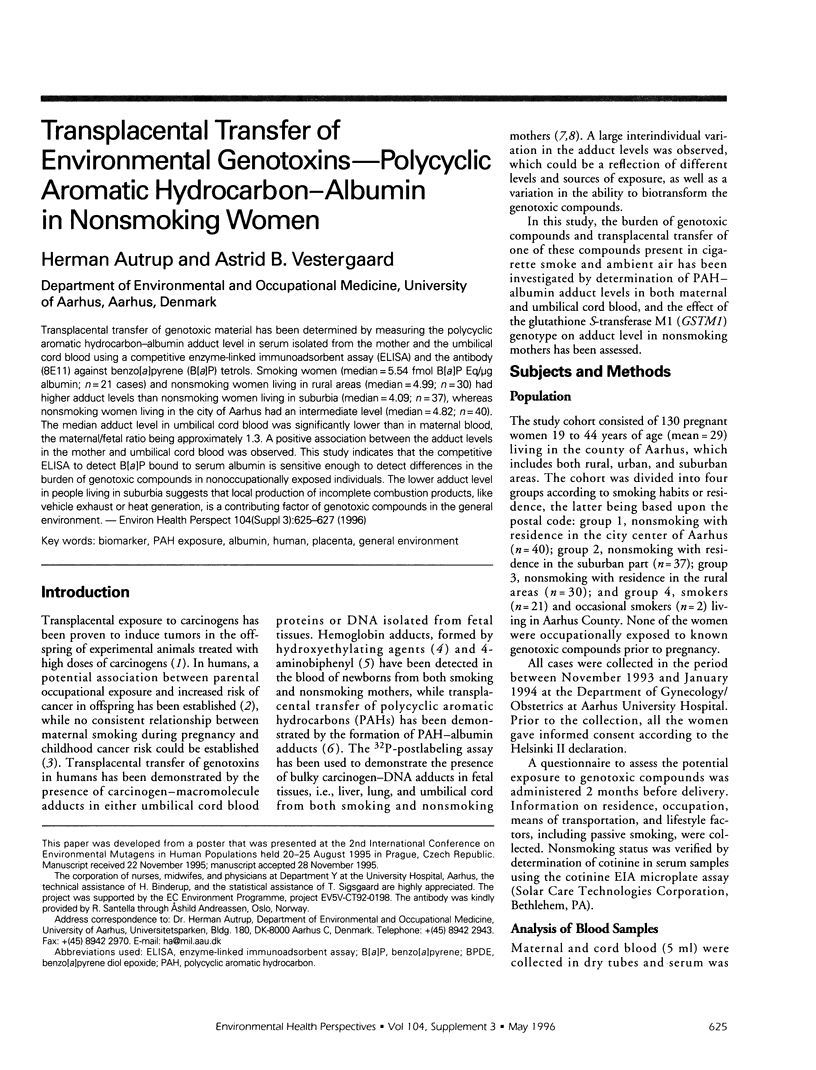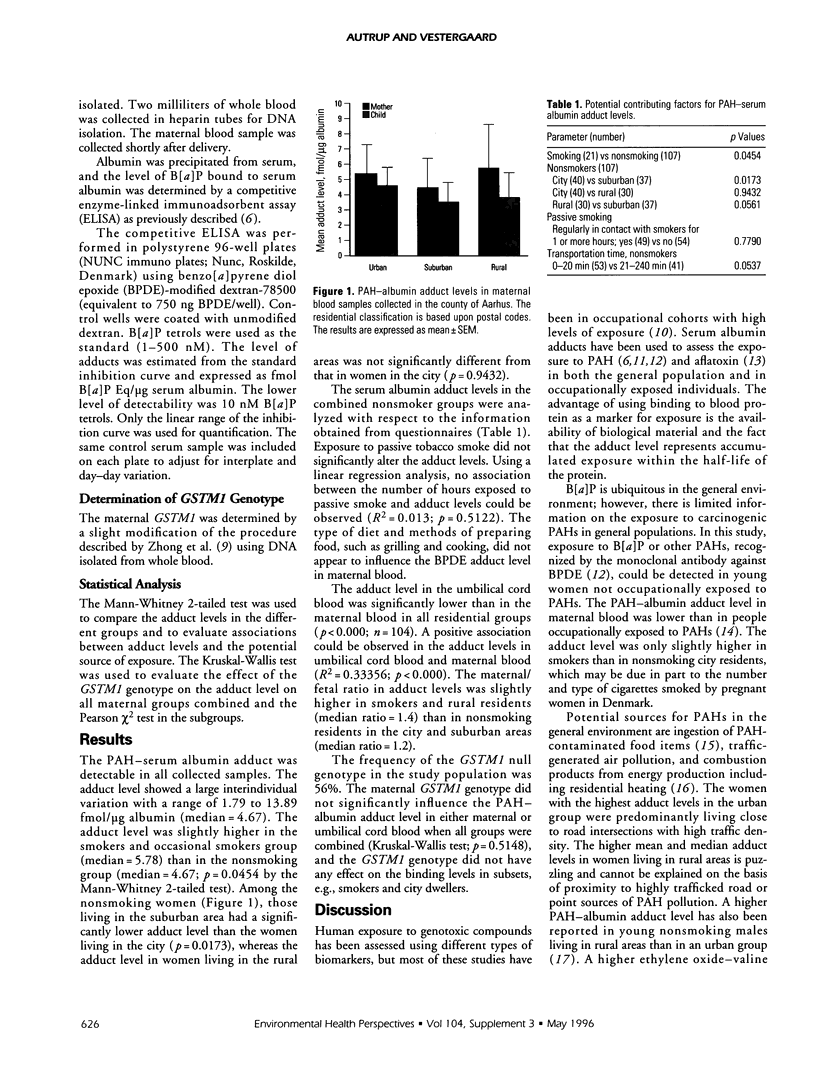Abstract
Transplacental transfer of genotoxic material has been determined by measuring the polycyclic aromatic hydrocarbon-albumin adduct level in serum isolated from the mother and the umbilical cord blood using a competitive enzyme-linked immunoadsorbent assay (ELISA) and the antibody (8E11( against benzo[a]pyrene (B[a]P) tetrols. Smoking women (median = 5.54 fmol B[a]P eq/micrograms albumin; n = 21 cases) and nonsmoking women living in rural areas (median = 4.99; n = 30) had higher adduct levels than nonsmoking women living in suburbia (median = 4.09; n = 37), whereas nonsmoking women living in the city of Aarhus had an intermediate level (median = 4.82; n = 40). The median adduct level in umbilical cord blood was significantly lower than in maternal blood, the maternal/fetal ratio being approximately 1.3. A positive association between the adduct levels in the mother and umbilical cord blood was observed. This study indicates that the competitive ELISA to detect B[a]P bound to serum albumin is sensitive enough to detect differences in the burden of genotoxic compounds in nonoccupationally exposed individuals. The lower adduct level in people living in suburbia suggests that local production of incomplete combustion products, like vehicle exhaust or heat generation, is a contributing factor to genotoxic compounds in the general environment.
Full text
PDF


Selected References
These references are in PubMed. This may not be the complete list of references from this article.
- Autrup H. Human exposure to genotoxic carcinogens: methods and their limitations. J Cancer Res Clin Oncol. 1991;117(1):6–12. doi: 10.1007/BF01613189. [DOI] [PubMed] [Google Scholar]
- Autrup H. Transplacental transfer of genotoxins and transplacental carcinogenesis. Environ Health Perspect. 1993 Jul;101 (Suppl 2):33–38. doi: 10.1289/ehp.93101s233. [DOI] [PMC free article] [PubMed] [Google Scholar]
- Autrup H., Vestergaard A. B., Okkels H. Transplacental transfer of environmental genotoxins: polycyclic aromatic hydrocarbon-albumin in non-smoking women, and the effect of maternal GSTM1 genotype. Carcinogenesis. 1995 Jun;16(6):1305–1309. doi: 10.1093/carcin/16.6.1305. [DOI] [PubMed] [Google Scholar]
- Autrup J. L., Schmidt J., Seremet T., Autrup H. Determination of exposure to aflatoxins among Danish workers in animal-feed production through the analysis of aflatoxin B1 adducts to serum albumin. Scand J Work Environ Health. 1991 Dec;17(6):436–440. doi: 10.5271/sjweh.1683. [DOI] [PubMed] [Google Scholar]
- Coghlin J., Gann P. H., Hammond S. K., Skipper P. L., Taghizadeh K., Paul M., Tannenbaum S. R. 4-Aminobiphenyl hemoglobin adducts in fetuses exposed to the tobacco smoke carcinogen in utero. J Natl Cancer Inst. 1991 Feb 20;83(4):274–280. doi: 10.1093/jnci/83.4.274. [DOI] [PubMed] [Google Scholar]
- Farmer P. B., Cordero R., Autrup H. Monitoring human exposure to 2-hydroxyethylating carcinogens. Environ Health Perspect. 1996 May;104 (Suppl 3):449–452. doi: 10.1289/ehp.96104s3449. [DOI] [PMC free article] [PubMed] [Google Scholar]
- Hansen C., Sørensen L. D., Asmussen I., Autrup H. Transplacental exposure to tobacco smoke in human-adduct formation in placenta and umbilical cord blood vessels. Teratog Carcinog Mutagen. 1992;12(2):51–60. doi: 10.1002/tcm.1770120202. [DOI] [PubMed] [Google Scholar]
- Hatch M. C., Warburton D., Santella R. M. Polycyclic aromatic hydrocarbon-DNA adducts in spontaneously aborted fetal tissue. Carcinogenesis. 1990 Sep;11(9):1673–1675. doi: 10.1093/carcin/11.9.1673. [DOI] [PubMed] [Google Scholar]
- Olsen J. H., de Nully Brown P., Schulgen G., Jensen O. M. Parental employment at time of conception and risk of cancer in offspring. Eur J Cancer. 1991;27(8):958–965. doi: 10.1016/0277-5379(91)90258-f. [DOI] [PubMed] [Google Scholar]
- Pershagen G., Ericson A., Otterblad-Olausson P. Maternal smoking in pregnancy: does it increase the risk of childhood cancer? Int J Epidemiol. 1992 Feb;21(1):1–5. doi: 10.1093/ije/21.1.1. [DOI] [PubMed] [Google Scholar]
- Santella R. M., Lin C. D., Dharmaraja N. Monoclonal antibodies to a benzo[a]pyrene diolepoxide modified protein. Carcinogenesis. 1986 Mar;7(3):441–444. doi: 10.1093/carcin/7.3.441. [DOI] [PubMed] [Google Scholar]
- Sherson D., Sabro P., Sigsgaard T., Johansen F., Autrup H. Biological monitoring of foundry workers exposed to polycyclic aromatic hydrocarbons. Br J Ind Med. 1990 Jul;47(7):448–453. doi: 10.1136/oem.47.7.448. [DOI] [PMC free article] [PubMed] [Google Scholar]
- Tas S., Buchet J. P., Lauwerys R. Determinants of benzo[a]pyrene diol epoxide adducts to albumin in workers exposed to polycyclic aromatic hydrocarbons. Int Arch Occup Environ Health. 1994;66(5):343–348. doi: 10.1007/BF00378368. [DOI] [PubMed] [Google Scholar]
- Tavares R., Ramos P., Palminha J., Bispo M. A., Paz I., Bras A., Rueff J., Farmer P. B., Bailey E. Transplacental exposure to genotoxins. Evaluation in haemoglobin of hydroxyethylvaline adduct levels in smoking and non-smoking mothers and their newborns. Carcinogenesis. 1994 Jun;15(6):1271–1274. doi: 10.1093/carcin/15.6.1271. [DOI] [PubMed] [Google Scholar]
- Zhong S., Wyllie A. H., Barnes D., Wolf C. R., Spurr N. K. Relationship between the GSTM1 genetic polymorphism and susceptibility to bladder, breast and colon cancer. Carcinogenesis. 1993 Sep;14(9):1821–1824. doi: 10.1093/carcin/14.9.1821. [DOI] [PubMed] [Google Scholar]
- de Vos R. H., van Dokkum W., Schouten A., de Jong-Berkhout P. Polycyclic aromatic hydrocarbons in Dutch total diet samples (1984-1986). Food Chem Toxicol. 1990 Apr;28(4):263–268. doi: 10.1016/0278-6915(90)90038-o. [DOI] [PubMed] [Google Scholar]


